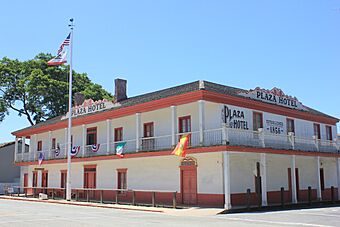San Juan Bautista State Historic Park facts for kids
|
San Juan Bautista Plaza Historic District
|
|

The Plaza Hotel houses the state park's entrance and a museum
|
|
| Location | 2211 Garden Road, San Juan Bautista, California |
|---|---|
| Area | 6 acres (2.4 ha) |
| Built | 1797 |
| Architectural style | Colonial |
| NRHP reference No. | 69000038 |
Quick facts for kids Significant dates |
|
| Added to NRHP | December 8, 1969 |
| Designated NHLD | April 15, 1970 |
San Juan Bautista State Historic Park is a special California state park. It protects the old center of San Juan Bautista, California, in the United States. This park keeps many buildings safe that show what California was like when Spain and Mexico ruled it.
The park includes the famous Plaza Hotel and the José Castro House. Several other historic buildings also face the main plaza. This area became a state park in 1933.
The park is part of a bigger place called the San Juan Bautista Plaza Historic District. This district also includes the nearby Mission San Juan Bautista and the Juan de Anza House. The entire district was named a National Historic Landmark in 1970. It is also a stop on the Juan Bautista de Anza National Historic Trail.
Contents
Discover San Juan Bautista State Historic Park
This park lets you step back in time. You can explore buildings from the 1700s and 1800s. These structures tell stories of early California.
A Glimpse into California's Past
The park helps us understand life during Spanish and Mexican rule. It shows how people lived and worked long ago. Many important events happened right here.
The Historic Mission San Juan Bautista
The Mission San Juan Bautista was started in 1797. It was the 15th Spanish mission built in what is now California. Its main goal was to teach local Native Americans about Roman Catholicism. The mission was very successful in its early years.
The large mission church you see today was built between 1803 and 1812. It is still an active Catholic church. The mission itself is next to the state park's plaza, but it is not part of the state park.
The Plaza Hotel: From Barracks to Museum
Across the plaza from the mission stands the Plaza Hotel. This building started its life in 1814. It was first used as a place for Spanish soldiers to live. In 1858, a second floor was added. This gave it a unique Monterey Colonial look. Today, the Plaza Hotel is home to a museum. It also serves as the main entrance for the state park.
The José Castro House: A Governor's Home
After Mexico became independent, the Spanish missions changed. In 1833, the missions were no longer controlled by the church. The small village around the mission grew into a pueblo, which is like a town.
On the southwest side of the plaza, you will find the adobe home of José Antonio Castro. He was an important leader in California when it was part of Mexico. He even served as interim Governor between 1835 and 1846. This house was built from 1839 to 1841. It is a great example of the Monterey Colonial building style. Now, it is a museum within the state park.
Other Important Buildings
Just one block southeast of the park is the Juan de Anza House. This adobe building was constructed even before the Monterey Colonial style became popular. It offers another look into early California architecture.
See also




